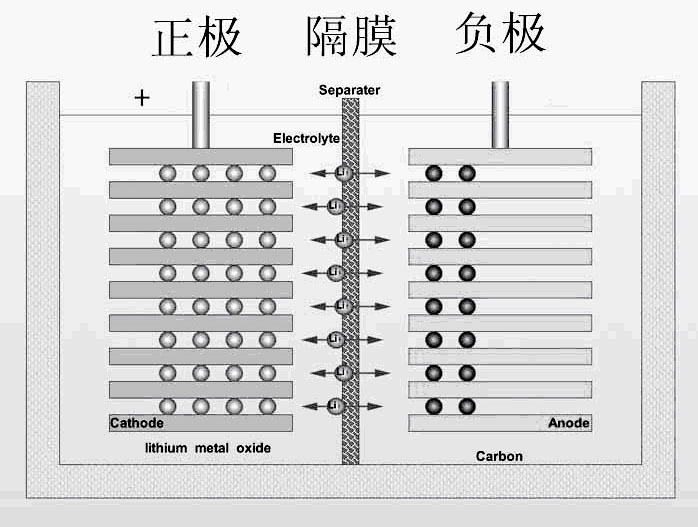High-safety aqueous and organic mixed lithium ion battery
A lithium-ion battery, high-safety technology, applied in the direction of battery electrodes, secondary batteries, battery components, etc., can solve the problems of poor cycle performance, difficulty in finding electrode pair materials, poor cycle performance, etc., and achieve long cycle life , low cost, and improved power characteristics
- Summary
- Abstract
- Description
- Claims
- Application Information
AI Technical Summary
Problems solved by technology
Method used
Image
Examples
Embodiment 1
[0019] The negative electrode material is made of natural graphite, and the slurry is mixed according to the ratio of graphite: conductive agent: binder = 85:5:10, and then evenly coated on the copper mesh collector fluid, dried and pressed to form an electrode. The cathode material is spinel-type LiMn for commercial lithium-ion batteries 2 o 4 . Positive electrode composition according to LiMn 2 o 4 : Carbon black: binder = 85:5:10 weight ratio mixed slurry, evenly coated on the nickel mesh current collector, dried and pressed into electrodes. In this embodiment, the actual capacity of the positive electrode material is 80 mAh / g, the negative electrode is 320 mAh / g, and the single-side coating amount of the positive electrode is 15 mg / cm 2 , the negative pole is 5 mg / cm 2. Then the two electrodes were cut according to the specifications, paired and assembled into a 2# battery (14 mm in diameter * 50 mm in height), the separator used was the separator of a commercial nic...
Embodiment 2
[0021] Adopt self-made composite separator to replace the separator of the commercial nickel-hydrogen battery in embodiment 1, its synthetic method is: Nasicon type LiTi 2 (PO 4 ) 3 The material was calcined in a tube furnace at 900°C for 1 hour until it melted, and then it was taken out and pressed into a film. After being cooled, it is ready for use, and the rest is the same as in Example 1, and the battery is prepared according to the steps and conditions in Example 1. In this embodiment, the actual capacity of the positive electrode material is 80 mAh / g, the negative electrode is 320 mAh / g, and the single-side coating amount of the positive electrode is 15 mg / cm 2 , the negative pole is 5 mg / cm 2 . In the working range of 0 V-4.3 V, the discharge current is 1C, the capacity is 1000 mAh, the average working voltage is 4.2 V, and the 10 C charge and discharge capacity is maintained at 800 mAh. After 100 cycles, the capacity retention rate can reach 70%. Compared with th...
Embodiment 3
[0023] The negative electrode material is hard carbon, and the slurry is mixed according to the ratio of graphite: conductive agent: binder = 85:5:10, and then evenly coated on the copper mesh collector, dried and pressed to form an electrode. The cathode material is spinel-type LiMn for commercial lithium-ion batteries 2 o 4 . Positive electrode composition according to LiMn 2 o 4 : Carbon black: binder = 85:5:10 weight ratio mixed slurry, evenly coated on the nickel mesh current collector, dried and pressed into electrodes. In this embodiment, the actual capacity of the positive electrode material is 80 mAh / g, the negative electrode is 160 mAh / g, and the single-side coating amount of the positive electrode is 10 mg / cm 2 , the negative pole is 5 mg / cm 2 . Then the two electrodes were cut according to the specifications, paired and assembled into a 2# battery (14 mm in diameter * 50 mm in height), the separator used was the separator of a commercial nickel-metal hydride ...
PUM
 Login to View More
Login to View More Abstract
Description
Claims
Application Information
 Login to View More
Login to View More - R&D
- Intellectual Property
- Life Sciences
- Materials
- Tech Scout
- Unparalleled Data Quality
- Higher Quality Content
- 60% Fewer Hallucinations
Browse by: Latest US Patents, China's latest patents, Technical Efficacy Thesaurus, Application Domain, Technology Topic, Popular Technical Reports.
© 2025 PatSnap. All rights reserved.Legal|Privacy policy|Modern Slavery Act Transparency Statement|Sitemap|About US| Contact US: help@patsnap.com


